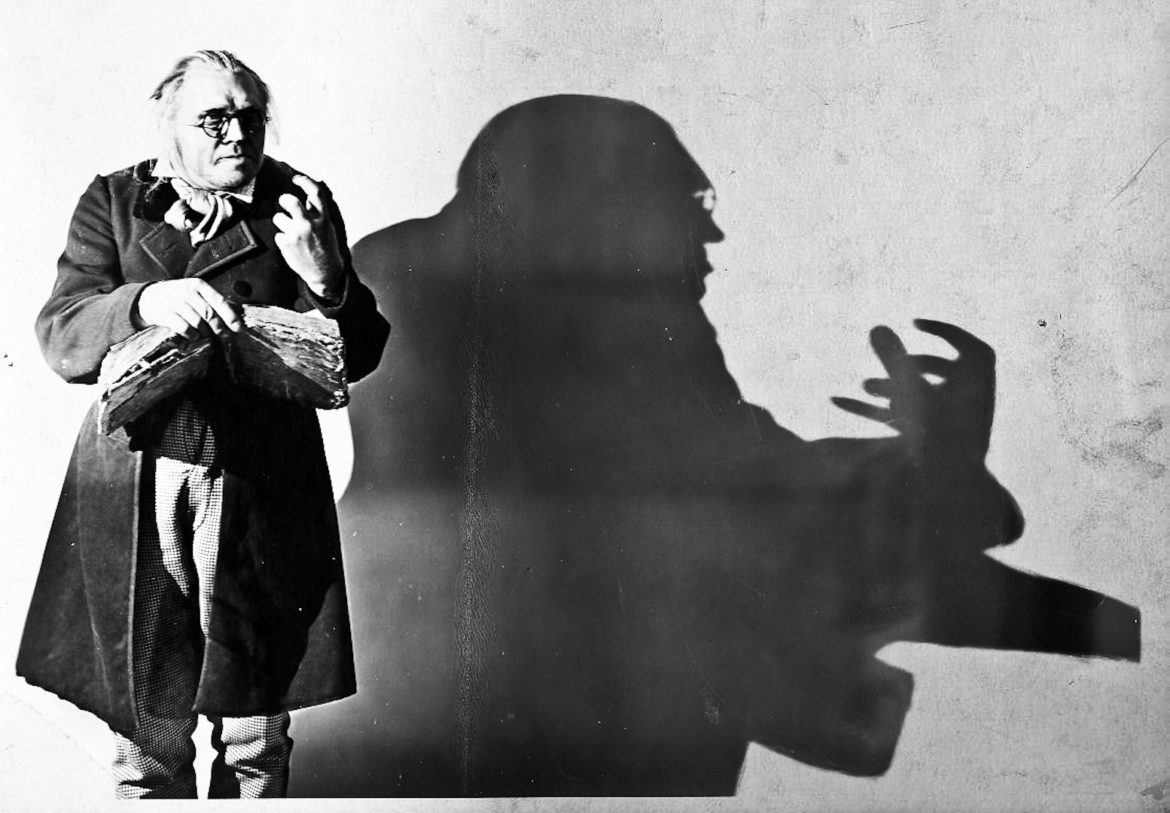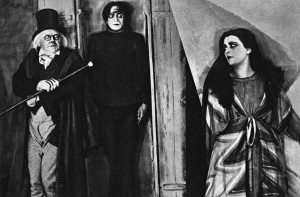Part of an ongoing effort to watch each of the films in Roger Ebert’s Great Movies series. The introduction and full list can be found here.
For the first time in this series, my viewing of The Cabinet of Dr Caligari marks a return to familiar material rather than a first showing. It’s a welcome return. Robert Wiene’s film, based on a story from Carl Mayer and Hans Janowitz, has lost none of its power to scare and amaze. Its jagged sets, crazy painted backdrops, and moments of pure terror all had a huge impact on movies to follow, especially horror movies, but even on its own terms, it still holds its own.
What struck me most rewatching it was how far we’d come in visual storytelling from even a few years prior. It was revolutionary for Birth of a Nation to cross-cut from a battle scene to a scene at home occurring simultaneously, and Griffith expanded on that in Broken Blossoms.
But in Caligari, there is a scene that cuts from the present day to the pages of a book people are reading, to a reimagining of the past when that book was being written, to the memories of its writer that inform its writing, to the present day where he is sleeping elsewhere, and on and on. (In fact, the entirety of this is a story someone even further on is telling, but let’s leave that aside for a moment).
It’s completely clear what’s happening, even though there are frames within frames, narratively. The idea that audiences couldn’t follow this sort of thing has apparently been left far behind. Storytelling — and unique, interesting, visual ways to tell those stories — has come to the fore.
But more on that later. In the first of the movie’s six acts, we meet Francis, who sits in the woods and recounts to another man his strange tale. His love and fiancée, Lucy, wanders through the frame, looking ghostly and/or angelic. It’s calm but there’s already a sense of foreboding, especially since Francis opens by claiming what they’ve been through in their town is far stranger than any story the man could tell.
 We flash back to his town, disorientingly rendered as a painted backdrop of compressed buildings, and from the bottom left of the screen, our title character emerges from slanted stairs.
We flash back to his town, disorientingly rendered as a painted backdrop of compressed buildings, and from the bottom left of the screen, our title character emerges from slanted stairs.
We also are introduced to Francis’ friend Alan, not long for this world. The two are close, and in an apartment full of windows, doors, and chairs at odd angles, we learn there’s a fair in town. Francis and Alan rush out to visit.
Caligari visits the town clerk, awkwardly perched on an improbably high post in his weird office, and secures a permit to present at the fair. He has a sleepwalker, or somnambulist, to display. The fair scenes are surreal – in a recurring motif, a tip-taking monkey is shown in the upper right corner of the screen as the image reveals hustle and bustle around him. There are spinning wheels in against the static, painted background, fairgoers of all sorts mill about in the front, and carnival performers pass by unremarked. Tod Browning’s Freaks might have borrowed a note or two here 12 years later.
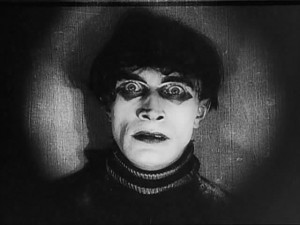 Caligari displays his somnambulist, named Cesare (Conrad Veidt), to the frightened crowd. For some reason, Cesare bears a resemblance to Transformer-era Lou Reed.
Caligari displays his somnambulist, named Cesare (Conrad Veidt), to the frightened crowd. For some reason, Cesare bears a resemblance to Transformer-era Lou Reed.
And for some reason, Cesare also knows the past and sees the future, so his services are on offer. Alan impetuously rushes forward to ask how long he will live, and Cesare gives an answer familiar to anyone who’s ever seen a horror movie: “until the break of dawn.” Wrong question, Alan. He’s understandably distraught, and the friends flee the carnival tent.
By morning, there’ve been some murders. Alan’s in particular is innovative and frightening, shot entirely in silhouette. Future gialli and slasher movies would recreate this over and over.
Francis learns of his friend’s fate, and the rash of murders across the city, and gradually connects it the somnambulist and his master, Caligari. But just as he and the cops close in, another suspect is rounded up, trying to kill an old woman. He’s a copycat taking advantage of the situation, but it’s enough to stall things for the real culprits.
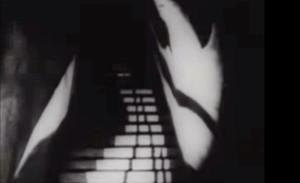 Throughout these sequences, the images become more and more jarring, off-kilter, moody, and stark. The castle-like stairs to the police station, for instance. There’s a nightmarish sense that things might not be all they seem. Calagari’s house is set at an impossible tilt, and his office is a whirlpool of books and boxes, and his famous cabinet, where Cesare rests and feeds.
Throughout these sequences, the images become more and more jarring, off-kilter, moody, and stark. The castle-like stairs to the police station, for instance. There’s a nightmarish sense that things might not be all they seem. Calagari’s house is set at an impossible tilt, and his office is a whirlpool of books and boxes, and his famous cabinet, where Cesare rests and feeds.
The suspect denies the earlier two crimes, and Francis is all-too-ready to believe him. He sets out for Caligari’s house to spy on him, and confirms Cesare’s presence there. But in the meantime, Lucy is attacked – terrifyingly – by someone who sure seems like Cesare. Either unwilling or unable to murder her, Cesare kidnaps her and runs out, through the zigzagging skyline.
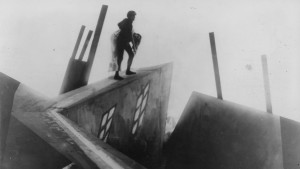 He eventually is pursued by townsfolk and abandons her to escape. Lucy recounts her horrible experience to Francis, who realizes there must be shenanigans afoot. He checks in with the cops, who rush to Caligari’s house and discover the body in the cabinet is a doll, a puppet. The real Cesare has been on the prowl this whole time.
He eventually is pursued by townsfolk and abandons her to escape. Lucy recounts her horrible experience to Francis, who realizes there must be shenanigans afoot. He checks in with the cops, who rush to Caligari’s house and discover the body in the cabinet is a doll, a puppet. The real Cesare has been on the prowl this whole time.
Francis pursues the mad doctor to (where else) the Insane Asylum, but there are surprises in store. Caligari is not the escaped patient he expects, but in fact the director of the place. And his name is not “Caligari.” In one of the great horror tropes, Francis and the other doctors discover a secret cache – an old, mystical text and a diary written by Caligari himself.
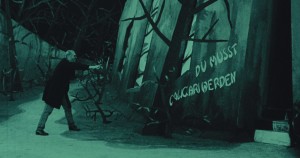 To continue making a short story long, they read both and discover the awful truth – the doctor has modeled himself after an 18th century mystic who could control the bodies of sleepwalkers and get them to commit evil acts. In one of the film’s most incredible sequences, mentioned above, we watch them read, read the book ourselves, flash back to Caligari learning, and flash forward to Caligari’s obsession, expressed on screen by the proliferation of overlaid text: “You must become Caligari!” This text appears in different fonts, sizes, in disjointed ways, but repeating the same maniacal sentence.
To continue making a short story long, they read both and discover the awful truth – the doctor has modeled himself after an 18th century mystic who could control the bodies of sleepwalkers and get them to commit evil acts. In one of the film’s most incredible sequences, mentioned above, we watch them read, read the book ourselves, flash back to Caligari learning, and flash forward to Caligari’s obsession, expressed on screen by the proliferation of overlaid text: “You must become Caligari!” This text appears in different fonts, sizes, in disjointed ways, but repeating the same maniacal sentence.
It’s a truly frightening vision of madness. The number of times we’ve heard someone’s inner demon scream at them has made it a cliché, but there’s no denying its power here.
In its final act, Caligari is confronted in his office and Francis demands he unmask himself. The mad doctor attacks one of his underlings, and is locked away.
But as we cut back to Francis and the man talking in the woods, it’s clear the pieces don’t fit. A final twist reveals things are, again, not what they seem.
Or are they? Apparently, the film’s writers objected to its ending, which was foisted on them by the studio. It’s an interesting question, especially in light of the many readings of the film that see it primarily as a warning about bowing to irrational authority, and how easily good men can be led to kill. Obviously, this has some resonances for German history – and both Mayer and Janowitz were disillusioned veterans of the first world war, and committed pacifists.
I won’t pretend to know. There does seem to be a hasty “But you’ll never guess what happened next!” sense to the ending, and I think it would work better without it. But even that has proved influential, as any fan of The Twilight Zone or detractor of M. Night Shyamalan will tell you.
Taken as a whole, The Cabinet of Dr. Caligari is an extraordinary film – technically, narratively, visually, and in terms of its influence. The deep expressionism of its incongruous sets and the boldness of its storytelling alone would’ve carved out its place in history. The performances are broad, but so are the images, so it makes sense. This was and remains one of my favorite films of all time.
A case can be made that “Caligari” was the first true horror film. There had been earlier ghost stories and the eerie serial “Fantomas” made in 1913-14, but their characters were inhabiting a recognizable world. “Caligari” creates a mindscape, a subjective psychological fantasy. In this world, unspeakable horror becomes possible.
Next up: F.W. Murnau’s Nosferatu.

